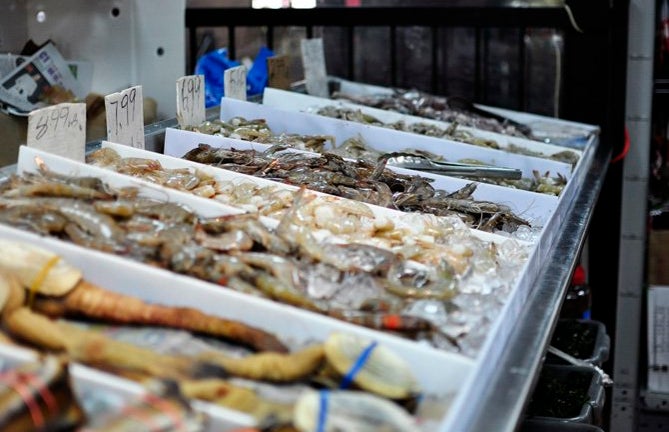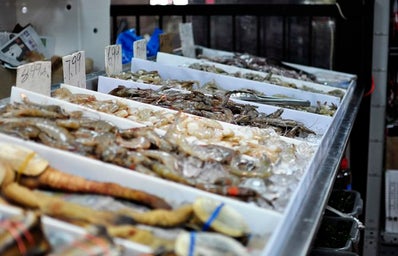Seafood fraud is a nationwide problem, threatening human health. According to NOAA, the three main groups of seafood fraud are organized as such; seafood substitution, short-weighing, and the mislabeling of seafood, creating a large market for illegally fished products.
-
Seafood Substitution: Once fish is filleted and skinned, its species can be difficult to determine. Some sellers take advantage of this and substitute a low-valued species for a more expensive one (for example, passing off catfish as grouper). The U.S. Food and Drug Administration conducted DNA testing on fish to determine the accuracy of the market names on their labels and found that fish species are correctly labeled 85% of the time. Although the “bait and switch” might be the most well-known type of seafood fraud, it is not the most common.
-
Short-Weighing: Less known, but far more common, is short-weighting—when processors misrepresent the weight of a seafood product through practices such as overglazing, soaking, and breading. Processors will often add a layer of ice or a preservative to keep a seafood product fresh, a normal and legal practice. However, when a processor uses excess ice (overglazing) or additives (soaking) and includes that weight with the net weight of the seafood, that’s fraud. Consumers should pay for the weight of the seafood alone. Short-weighting charges consumers more for less seafood.
- Mislabeling: Sometimes other qualities of seafood are mislabeled in addition to the species name—such as the country of origin—to avoid regulations and fees, or even to sneak illegally caught fish into the supply chain. This can occur through: Transshipping—when seafood products are exported through different countries to avoid duties and tariffs. At-sea transfers—when illegal fishing vessels transfer their catch to cargo vessels carrying legitimately caught seafood. Falsifying trade documents. Mislabeling seafood and concealing illegally caught fish evades inspection fees, permits, and other business costs that affect the price of responsibly caught seafood.
Despite FDA and NOAA regulations, studies show that there is a concerning growth in this industry. In a 2019 article for National Geographic scientists examine samples of fish from restaurants, seafood markets, and large grocery stores were sent to a lab for DNA analysis. According to their research, “sea bass and snapper were the most mislabeled species,” these fish are commonly ordered at restaurants and are more likely to be mislabeled than fish bought at markets or grocery stores. In Oceana’s most recent seafood fraud report, “1 in every 5 of the 449 fish tested (21%) were mislabeled and 1 out of every 3 establishments visited sold mislabeled seafood.” In perspective these numbers are frightening, especially when you think about how often you go into an establishment to order fish, which is “more frequently mislabeled at restaurants (26%) and smaller markets (24%) than at larger chain grocery stores (12%). Of the species tested, sea bass and snapper had the “highest rates of mislabeling (55% and 42%).” With these estimates, it is alarming that most of the seafood we may consume are typically not what we are expecting.
In addition to the concern of being scammed, seafood fraud is a threat causing major issues linked to human health. Substitution of fish, especially if mislabeled, can contain a wide range of potential toxins, pathogens, and allergens that may be concealed to the public. The CDC reported one major health concern in conjunction with seafood fraud. Ciguatera is an illness caused by “eating fish that contain toxins,” having symptoms such as “nausea, diarrhea, numbness, blurred vision and even reverse temperature sensation,” where hot feels cold and cold feels hot. The CDC also stated that there is still no cure to this poisoning and the “symptoms usually go away in days or weeks but can last for years” however, the infected person may be treated. According to Oceana this “formerly occurred primarily in tropical regions but is now increasingly imported along with the large reef fish that carry this form of food poisoning.” Due to high demand in seafood supply, “around 90% of the seafood consumed in the United States is imported.” It is evident that even with regulations in place, more than half of what is reported goes unnoticed to the public because the complexity of seafood trade creates opportunities for fraud.
According to the National Ocean Council Committee on IUU Fishing and Seafood Fraud, fraudulent activities include; “transshipping (when seafood products are exported through different countries to avoid duties and tariffs), at-sea transfers (when illegal fishing vessels transfer their catch to cargo vessels carrying legitimately caught seafood), and falsifying trade documents.” This is concerning since the public is consuming seafood that is being wrongfully labeled.
Not only does the human body take an effect but so do costs. Mislabeling seafood and concealing illegally caught fish avoids “inspection fees, permits, and other business costs that affect the price of responsibly caught seafood”. The prices of seafood matter because dramatic price differences among substitutes create a cash incentive for fraudulent actions. According to an in-depth survey of restaurant seafood prices from Oceana, the retail price difference between farmed and wild salmon was “more than $6 on average per serving, while the price difference between red snapper and tilapia was roughly $7 per serving,” which add up to significant amounts of money to be made by illegally swapping one species for another.
Significant financial benefits for fraud exist at every step of the supply network (fishermen, dealers, wholesale and retail sales). The current system for identifying, tracking and enforcing the U.S. seafood supply is inefficient. While the FDA is often criticized for their less-than-strict inspection and enforcement efforts when it comes to seafood fraud, they started using a new DNA-sequencing equipment in 9 of the major labs across the country in a push to diminish this type of substitution. Researchers say they are targeting “cod, grouper, snapper, tuna and other high-value species (which are more likely to be substituted) and have already begun sequencing samples” taken from retailers and wholesalers.
Seafood traceability is a key to stopping fraud and would make certain that all seafood sold in the U.S. is safe, legally caught and honestly labeled while providing consumers with more information about their seafood. According to Oceana’s report, “tracking seafood from boat to plate will allow verification of products that will help reduce seafood fraud and keep illegally caught fish out of the supply chain” while allowing consumers to have access to basic information about their seafood purchase (the name of the fish, where, when and how it was caught, and whether it stayed frozen the entire time up to delivery). Setting prices without clear information about what is being sold exposes consumers and retailers to fraud and generates unfair competition for honest fishermen and seafood businesses. This problem currently “affects more than 90% of the U.S. seafood supply”, which is imported from around the world with no transparency about its handling along the way.
My argument is that the government should require traceability throughout the supply network while providing clear information on seafood origins to ensure fair prices and that the seafood we eat is safe, legally caught and truthfully labeled. With all of this said, what do you think ‘we’ should do about this issue? DNA testing can be an expensive and lengthy process, especially if you’re making a simple meal or you’re out to lunch. However, I highly recommend asking questions to sellers regarding the origin of the product, avoiding highly processed products and purchasing whole fish from a market if possible.


